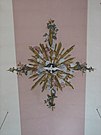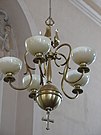City Church (Arolsen)
The Protestant town church Arolsen is a listed church in Bad Arolsen in the north Hessian district of Waldeck-Frankenberg in the state of Hesse . It belongs to the Evangelical Church of Kurhessen-Waldeck .
history
The foundation stone was laid on August 16, 1735, Prince Karl August Friedrich zu Waldeck-Pyrmont . The construction was initially carried out according to plans by Julius Ludwig Rothweil ; about 16 years after Prince Friedrich Anton Ulrich von Waldeck and Pyrmont's decree to found the city of Arolsen. Rothweil was followed by two other builders: Franz Friedrich Rothweil (site management 1742–1768) and Johann Matthäus Kitz (site management 1768–1788).
The topping-out ceremony was celebrated on November 19, 1756, followed by long breaks in construction. From November 1769, when the installation of church windows was completed, there were funeral services in the unfinished church. The town church was consecrated on September 16, 1787.
architecture
The church is designed strictly mirror-inverted according to the Eisenach regulation , but it is not traditionally easted , but "wested" on the orders of the manor, i.e. it is built rotated by 180 degrees. The chancel is therefore to the west of the building, because the church is at the western end of the street leading to the castle: the tower with the main portal should face the residential castle and not face away. The sacred building was subordinated to the princely drawing board symmetry of the city of Arolsen 300 years ago.
The interior of the nave looks almost like a rectangle, the upper center of which is marked by a stucco dove with a halo on the ceiling. In the west is the chancel with pulpit and gallery over arched arcades, in the east the organ gallery. The architectural style of the interior is no longer baroque , but rococo because of the long construction time . The two cross arms of the floor plan are - also because of the boxes set up there - optically kept so short that the interior appears like a rectangular central building.
The church is a sandstone building with similar portals on all four sides with double-leaf oak doors. High arched windows lead the view to the slate-covered hipped roof and to the tower with a baroque dome and weather vane, decorated with the Waldecker Stern and the year 1788.
The construction time was 52 years - due to the persistent lack of money and the war-related interruptions from 1735 to 1787.
The architectural center of Bad Arolsen today is the Protestant church - and not, as planned 300 years ago, the Residenzschloss: The original building plans, according to which, analogous to the western urban area between the Residenzschloss and the church, an eastern urban area is mirror-inverted and of the same size eastwards Castle should be built, were not realized. In addition, the town west of the church continued to grow due to the railway line and train station.
Furnishing
General
The interior was designed in the Rococo style. Master carpenter Johann Wilhelm Kaulbach made 1786-1787 pulpit, altar, choir loft and pews . The organ prospectus comes from court sculptor Marcus Christoph Krau from 1782, the associated organ with two manuals, pedal and 26 registers was created by Johann Stephan Heeren . The organ work was newly created in 1973 by the Noeske organ workshop from Rotenburg an der Fulda, it has three manuals, pedal and 37 stops.
On the altar, the bronze crucifix and candlesticks are made by the artist Pohl from Kassel, whose son completed the Easter candle stand.
The ceiling has double grooves with white gold stucco decoration. On the side walls, the names of around 120 soldiers from the Principality who fell between 1870 and 1871 are listed on two tall black steles. In the altar area there are two steles , one of which shows Rauch's profile head.
The original church bells were cast in 1772, and since they were recovered in 1948 they have had the inscriptions “Glory to God in the highest”, “And peace on earth” and “A pleasure to the people”.
"Faith, Love, Hope" by Christian Daniel Rauch

The three white sculptures made of Carrara marble are a gift from the Arolsen-born sculptor Christian Daniel Rauch , who created them in 1844 (“Faith”, “Love”) and 1852 (“Hope”). They symbolize the Christian virtues " faith, love, hope " (cf. 1 Corinthians 13:13 ). The three figures stood in the chancel until 1957, when they were moved into the door niche of the north portal during the renovation in 1957.
The dean i. R. Heinz Gerlach interprets the group of figures as follows: “'Faith' reads the Bible and has its head bowed downwards. It shows what it is based on. 'Love' carries the flame in a bowl in front of it, its gaze is directed forward at the viewer, as if it wanted to offer to ignite his heart as well. 'Hope' is raised right up, it is shown as the tallest figure with arms stretched up and in a receiving, opening posture. 'Faith' leans towards the foundation of his faith, the Bible . 'Love' looks at the viewer and seeks reciprocal love in the present. 'Hope' turns to the heights, reaches out for what is to come. "
photos
Colloquium 2019
The theme of the 8th colloquium of the scientific conference series ars ecclesia - art on site was "The Protestant Church of Arolsen: history, architecture, furnishings". The organizers were the Museum Bad Arolsen and the Seminar for Art and Art History of the Technical University of Dortmund in cooperation with the Evangelical Martin Luther Congregation Bad Arolsen. The conference took place on October 19, 2019 in Bad Arolsen.
literature
- Michael Neumann: The city church in Arolsen - a sacred building as part of baroque urban planning . Ed .: Museum of the City of Arolsen and Museum Association Arolsen eV Museum of the City of Arolsen and Museum Association Arolsen eV, Bad Arolsen 1996, ISBN 3-930930-01-3 , p. 68 .
- Georg Dehio : Handbook of German art monuments, Hessen I, administrative districts of Giessen and Kassel. Founded on the Day of the Preservation of Monuments in 1900, continued by Ernst Gall, edited by Folkhard Cremer, Tobias Michael Wolf and others. Deutscher Kunstverlag, Munich / Berlin 2008, ISBN 978-3-422-03092-3 .
Web links
- Evangelical town church in Bad Arolsen. In: HNA Regiowiki . 19th October 2016.
- Ev. Bad Arolsen town church. In: waldecker-land.de.
- Website of the Evangelical Martin Luther Congregation - Bad Arolsen
- Evangelical Martin Luther Congregation Bad Arolsen. In: badarolsen.de.
Individual evidence
- ↑ “A tour of the Ev. Stadtkirche Bad Arolsen ”, flyer / information sheet of the Evangelical Church Community Bad Arolsen, printed on both sides, with images, undated. Source: Original, accessed July 23, 2019
- ^ Elmar Schulten: Works of art and food for thought from Dean i. R. Heinz Gerlach: Arolser church service is about digital offerings as a substitute religion. In: Waldeckische Landeszeitung . July 16, 2019, accessed July 25, 2019 .
- ↑ Dean Heinz Gerlach: Faith - Love - Hope. Contemplation of the marble figures by Christian Daniel Rauch in the town church of Arolsen . Double-page information sheet, undated (before 2019), is available for reading in the Arolsen Church; Source: Original, accessed July 25, 2019.
-
↑ The Protestant Church of Arolsen: for town and court. In: bad-arolsen.de. Retrieved July 25, 2019 . ars ecclesia: art on site. Technical University Dortmund, Seminar for Art and Art History, accessed on August 12, 2019 .
Coordinates: 51 ° 22 ′ 49.1 ″ N , 9 ° 0 ′ 56.6 ″ E









